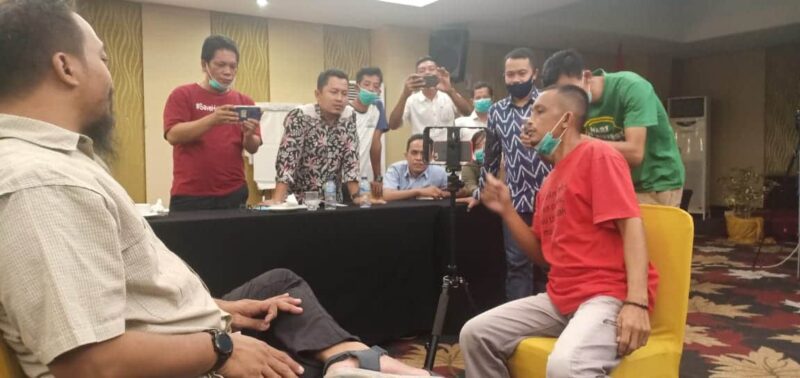By Gerson Merari
The Indigenous people of the Mentawai Islands in western Indonesia live according to Indigenous wisdom that has been passed down through generations. But they are often marginalized by government policies that aim for economic growth rather than protecting the natural resources on which they depend, and they say they seldom see any benefits from the companies that extract those products.
In the last 20 years, Mentawai’s forests have increasingly come under threat from companies that have received permits from the central government to develop palm oil plantations or harvest timber and other resources.
By clearing the forests, these concessions have degraded the land, leading to landslides and flash floods. They’ve also taken territory from communities that previously used it to grow food, increasing nutritional insecurity.
The Indigenous Mentawai people have protested the granting of these permits in defense of their ancestral lands. The Sabulukkang and Satoutou tribes, for example, recently spoke out against an industrial forestry permit that was issued for a 20,000-hectare biomass plantation in Central Siberut. Yet struggles like these have not been covered by local or national media.
Enter MentawaiKita, or “We Are Mentawai,” a community radio station, newspaper and now online news portal working to voice the concerns of the Mentawai people and report on the climate and environment.
Led by the Citra Mandiri Mentawai Foundation (YCM), MentawaiKita.com receives about 36,000 pageviews every month, said YCM Director Rifai.
For now, access to the internet remains limited on this remote strand of islands located about 150 kilometers off the coast of west Sumatra. However, as this access increases along with the use of mobile phones, Rifai said reporters will need to be ready with the tools to inform their community and tell stories. And one element that is missing from these reports is video.
Video is a potent medium through which to tell a story, especially about environmental degradation, said Rifai.
So last month, with the support of the Earth Journalism Network (EJN), YCM held a journalism training for 12 indigenous journalists aimed at boosting their ability to tell stories about the threats facing their environment. The training was the first of five planned to increase the capacity of indigenous journalists and communicators to produce news using video.
Over the course of three days, participants learned not just how to shoot video but also the basics of cinematography, video editing skills, camera blocking for better framing, and how to conduct interviews. Lead trainer Wahyu Mulyono also invited participants to dig deeper, using documentary lenses, to help journalists tell their stories.
Video reporting by the community
Part of a media grant through EJN’s Asia-Pacific project, the program is also focused on supporting women storytellers by teaching them how to report about their environment using a mobile phone.
Mentawai women play an important role in domestic affairs, especially by providing food for the family, Rifai explained. But they are often ignored when it comes to customary decisions.
“Having a specific program for the Mentawai women allows a more comfortable space for them to express themselves and better build their confidence, allowing them to have a higher level of participation in the training,” he said.
Wahyu, an established journalist and documentary filmmaker, said that in an increasingly digital era, video is a crucial way journalists can reach larger audiences.
“If the story is packaged well, then the message we are trying to convey through audio-visual media can be conveyed well, and we get the engagement we want,” he explained.
Practice makes perfect
Wahyu said the quality of the video produced through the first training varied. Some were good, but others needed more work.
Making audio-visual content or film requires a long training process, he said, so it is necessary for journalists to continue to practice creating content.
The challenge for participants, Wahyu added, is how to transfer the written language into visuals.
“From the results of the short training, it can be seen that they now have a better understanding of how to speak visually,” he said.
Bambang Sagurung, a journalist from Sikabaluan, Mentawai, who participated in the training, said he picked up several new skills.
“For example, how to find a good opening for a video or documentary film, what preparation must be made, the shoot, then the various formats of recording visuals, from medium to close up, to make it more interesting. Also, camera positioning during the interview with the source person,” explained Bambang.
He suggested that the training be followed up with special sessions on editing to optimize the content.
“It would be a shame if we are only able to inform the public about the riches of Mentawai – for instance, about its culture, nature, the people, and education — [through] text. In the presentation of news, journalistic video amidst the development of technology today is very important.”
Gerson Merari is a journalist for MentawaiKita and a member of the Saleleubaja Indigenous community. He participated in the training and documented the process.
(Banner photo: Trainer Wahyu Mulyono volunteers to be interviewed while being recorded during one of the practice sessions. Credit: Yayasan Citra Mandiri Mentawai)
